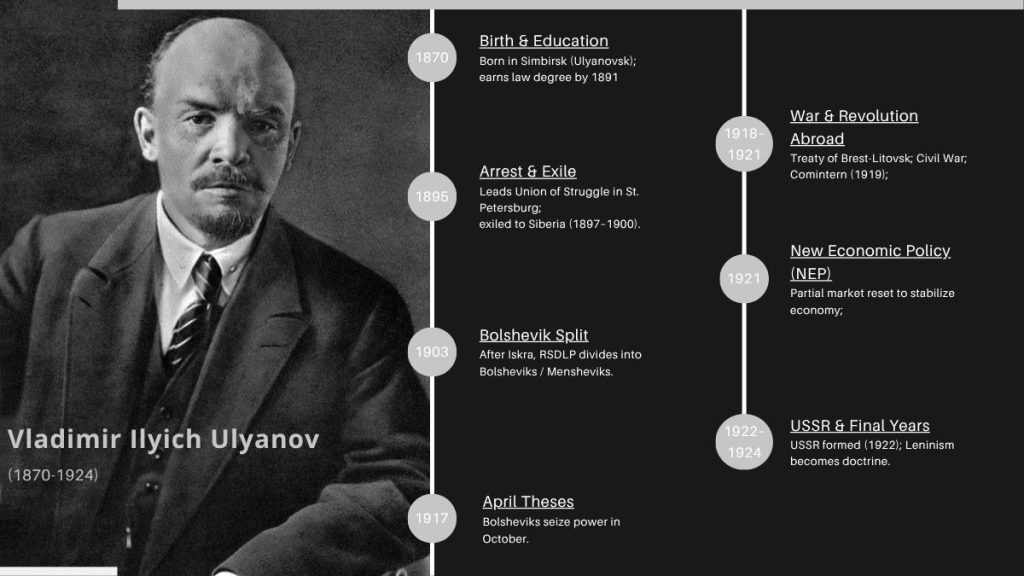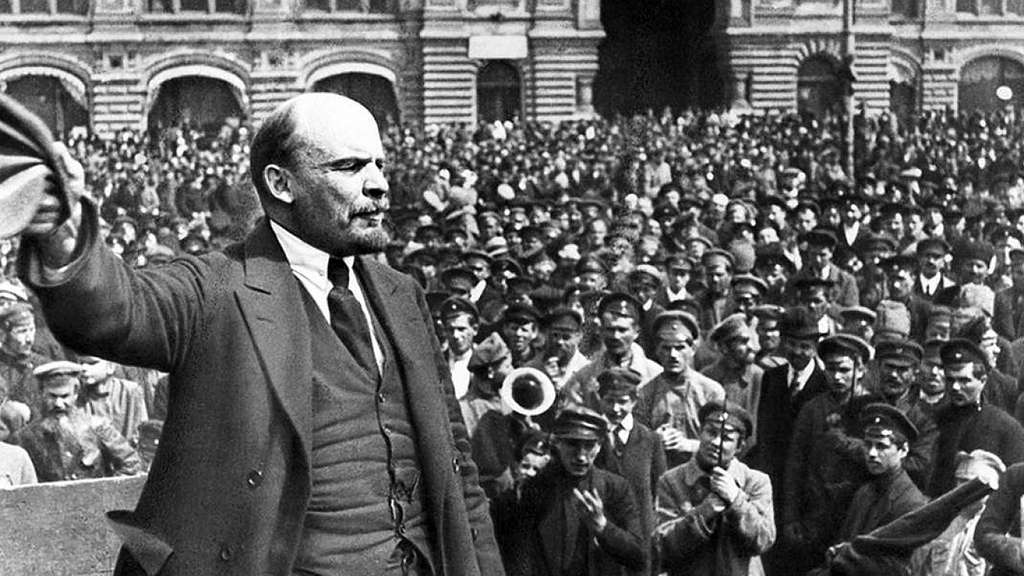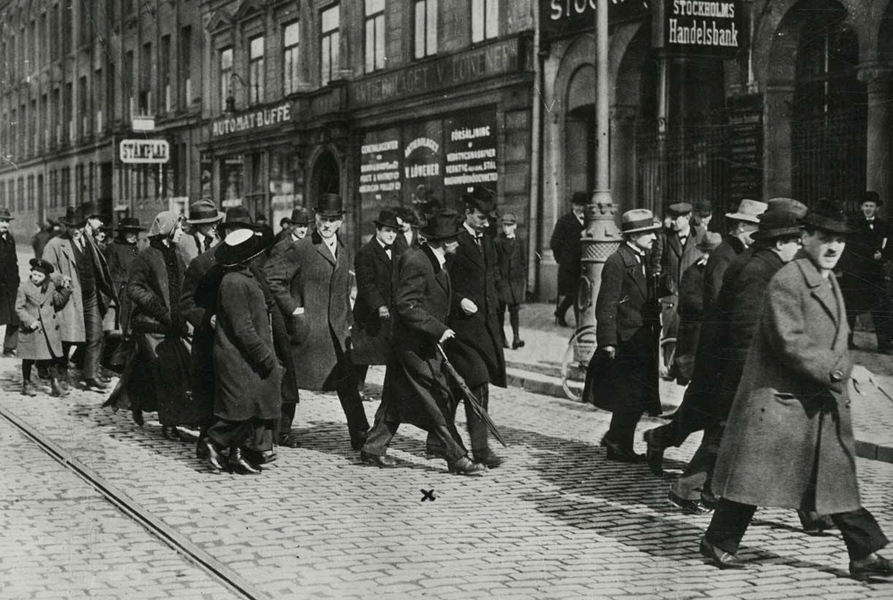Vladimir Ilyich Ulyanov, known globally as Vladimir Lenin, was a Russian revolutionary, politician, and theorist. He significantly influenced the 20th century. As the first leader of Soviet Russia from 1917 to 1924 and the Soviet Union from 1922 to 1924, Lenin led the October Revolution. He also established a new political system. For those inquiring about Lenin, his legacy is marked by radical change and ongoing controversy.
Lenin was a key figure in the Bolshevik faction of the Russian Social Democratic Labour Party. He built a disciplined movement that took control in 1917. His government made significant decisions, including the Treaty of Brest-Litovsk to exit World War I, nationalizing major industries and banks, and abolishing private land ownership. These actions laid the groundwork for a one-party state under the Communist Party, shaping the early Soviet system.
As a dedicated Marxist, Lenin developed Leninism and founded the Communist International, or Comintern, to promote global revolution. During the Russian Civil War, his regime employed the Red Terror and expanded state control to secure victory. Supporters praise Lenin for his decisive actions and clear program. Critics, on the other hand, condemn the repression and the establishment of a dictatorship.
Lenin suffered three strokes in 1922 and 1923 and passed away on January 21, 1924, at 53. His embalmed body remains in Lenin’s Mausoleum on Red Square, symbolizing both power and ongoing debate. The question of who was Vladimir Lenin? continues to influence discussions on revolution, ideology, and state power. Any biography of Lenin must confront his complex and polarizing legacy as the Bolshevik leader.

Vladimir Ilyich Ulyanov: Early Life, Education and Family Background
The early years of Vladimir Ilyich Ulyanov are essential in any serious Vladimir Lenin story. Born into a household that valued education, he grew up surrounded by ambition, discipline, and a commitment to public service. These influences are key to understanding who Vladimir Lenin was, long before politics became his defining feature.
Birth in Simbirsk and the Ulyanov Family
He was born on April 22, 1870 (April 10, O.S.) in Simbirsk, on the Volga River, later renamed Ulyanovsk. The Ulyanovs were a large, close-knit family with eight children. His father, Ilya Ulyanov, rose from humble beginnings to become Director of Public Schools for Simbirsk province. He opened over 450 schools and was awarded the Order of Saint Vladimir and hereditary nobility in 1882.
His mother, Maria Alexandrovna (née Blank), came from a well-educated background. Her mother was Swedish Lutheran, and her father Russian Jewish, who converted to Christianity. The family followed Russian Orthodoxy, but the mother’s religious indifference created a secular atmosphere at home—a detail critical to Lenin’s future.
Academic Excellence and Early Atheism
At the Simbirsk Classical Gymnasium, Vladimir Ilyich Ulyanov excelled, finishing first in his class with a gold medal. He was an avid chess player, enjoyed the outdoors, and worked with intense focus. After his father’s death in 1886, he turned to atheism, a shift that later sparked debates over his moral and intellectual character.
Alexander Ulyanov’s Execution and Political Radicalization
In May 1887, his older brother Aleksandr Ulyanov was executed for plotting to assassinate Tsar Alexander III. This event marked a significant turning point in the family’s life and his own political views. At 17, he took on new household duties and absorbed the shock, a moment often highlighted in any candid Vladimir Lenin biography.
Kazan University Expulsion and Independent Law Degree
He entered the law faculty at Kazan Imperial University in 1887 but was expelled within months for joining an illegal student assembly. Arrested and banished to Kokushkino, he later returned to Kazan without readmission. By January 1889, after reading Karl Marx’s Das Kapital and meeting older revolutionaries, he embraced Marxism.
In 1890, with his mother’s petition, he secured permission to sit external law exams in Saint Petersburg. He earned an honors law degree in 1891. The family had moved to Samara in 1889, where he joined socialist circles, circulated and studied Russian translations of The Communist Manifesto, studied Georgi Plekhanov, and critiqued Narodnik agrarian theories with data. These steps reveal Vladimir Lenin’s disciplined approach to study and politics, a profile consistent with the broader Vladimir Lenin biography.

From Revolutionary Activist to Bolshevik Leader
By the mid-1890s, Vladimir Lenin’s journey took a significant turn from legal work to underground politics. This period saw him build networks, write polemics, and test tactics. These efforts would later shape the Russian Revolution.
Marxist Circles in St. Petersburg and Siberian Exile
Upon arriving in St. Petersburg in 1893, Lenin assisted a barrister while organizing Social-Democratic circles in factories. He led workers’ study groups and printed illegal essays, including What the “Friends of the People” Are and How They Fight the Social-Democrats.
Police arrested him in 1895 as he prepared the underground paper Rabochee delo. He spent a year in prison refining arguments that an urban proletariat could overthrow tsarist rule. In 1897, he was sent to Shushenskoye, Siberia, where he wrote under surveillance yet stayed in touch with Georgi Plekhanov and Pavel Axelrod.
Marriage to Nadezhda Krupskaya and Pseudonym “Lenin”
Nadezhda Krupskaya, a Marxist schoolteacher arrested in 1896, joined him in exile. They married on July 10, 1898. He produced works such as A Protest by Russian Social-Democrats and The Development of Capitalism in Russia, then published as Vladimir Ilin.
Leaving exile, he moved through Pskov to Western Europe to widen the network. In December 1901, he adopted the pen name “Lenin,” a signature that soon marked a rising Bolshevik leader with a clear program.
Iskra and the Vanguard Party
From bases in Munich, London, and Geneva, he helped launch Iskra, an RSDLP newspaper smuggled into Russia. The paper aimed to unify factions and coordinate strikes and debate.
In 1902, he published What Is to Be Done?, pressing for a disciplined vanguard of professional revolutionaries. He criticized rivals, including the Socialist Revolutionary Party, and in To the Village Poor briefly emphasized peasant power. These arguments set a path that fed directly into the Russian Revolution.
Bolsheviks vs. Mensheviks: The Party Split
At the RSDLP’s 1903 London Congress, Julius Martov clashed with Lenin over membership rules and party discipline. The result was a split: Bolsheviks favored centralized leadership; Mensheviks backed looser structures and autonomy.
Lenin left the Iskra board and wrote One Step Forward, Two Steps Back in 1904 to defend his stance. By 1905, a Bolshevik-led Central Committee launched Vperyod, cementing the organizational model central to Lenin’s biography and the rise of a Bolshevik leader during the Russian Revolution.

Why was Vladimir Lenin Important?
Vladimir Lenin was the founder of the Russian Communist Party (Bolsheviks). He was the mastermind behind the October coup and the first leader of the Soviet state. His leadership transformed the country’s land, industry, and party structure. He established a model for one-party rule and emergency measures during civil unrest.
As the leader of Soviet Russia from 1917 and the Soviet Union from 1922, Lenin implemented nationalization and abolished private land ownership. He centralized power through the party. He also created the Communist International to support global revolutions and developed a doctrine that merged with Marxism to form Marxism–Leninism.
Lenin’s journey included clandestine activities, exile in Siberia and Western Europe, and adopting a pseudonym in 1901. He survived an assassination attempt in 1918. From 1922, strokes limited his activities until his death in 1924. His legacy has sparked debates on revolutionary authority and the use of coercion.
The legacy of Lenin remains central to Russian and global history. His supporters see him as a decisive leader who seized the opportunity of 1917’s crisis. Critics, on the other hand, point to the Red Terror and suppression of opposition. These perspectives continue to shape our understanding of Lenin’s impact.
| Role | Timeframe | Key actions | Impact on the Soviet state |
|---|---|---|---|
| Founder of the Bolsheviks | 1903–1917 | Built a vanguard party; argued for disciplined organization | Created the apparatus that later governed |
| Leader of the Revolution | 1917 | April Theses; October takeover | Shifted power from Provisional Government to soviets |
| Head of Government (RSFSR/USSR) | 1917–1924 / 1923–1924 | Nationalization; abolition of private landownership | Centralized rule; emergency economics |
| International organizer | 1919–1924 | Founded the Comintern | Linked Moscow to parties across Europe & Asia |
| Theorist | 1902–1924 | Vanguard party, democratic centralism | Embedded Leninism in state/party doctrine |
Lenin and the Russian Revolution: 1917 Civil War and State-Building
In 1917, In 1917, amid war and crisis, Lenin returned to Petrograd, reshaping power. Lenin, at the heart of the Russian Revolution, pushed for swift change and a break with the past. The establishment of a one-party state was a result of decisions aimed at survival and control.
April Theses and the October Revolution
Lenin arrived in April 1917, via a sealed train through Germany, with a mission to end Russia’s involvement in World War I. His April Theses called for power to the Soviets, land for peasants, and a socialist republic. As the Bolshevik leader, he urged the party to seize the moment, challenging the Provisional Government.
In October, Bolshevik forces took control of key sites in Petrograd and arrested government ministers. Critics saw this as a coup; supporters viewed it as a mandate from the Soviets. The power shift led to Lenin heading the Council of People’s Commissars.
Treaty of Brest-Litovsk and War Communism
The Treaty of Brest-Litovsk, signed in March 1918, ended Russia’s involvement in the war, ceding vast territories to Germany. This move bought time, averting collapse and allowing the regime to focus on internal struggles. Banks and heavy industry were nationalized, and private land ownership was abolished.
War Communism followed, centralizing production and requisitioning grain for the Red Army. Rationing, factory discipline, and command distribution became the norm. These measures, though harsh, kept the economy afloat during wartime.
Red Terror, One-Party Rule and the Civil War
The Cheka, under Felix Dzerzhinsky, initiated the Red Terror against perceived enemies, including former officers and rival socialists. Arrests, executions, and labour camps expanded as the conflict intensified. The revolution hardened into a defensive regime under siege.
From 1918 to 1921, the Red Army fought against White forces, foreign expeditions, and separatist movements. Victory solidified a one-party state, with Lenin at the forefront of strategy and propaganda.
Founding the Soviet Union and Leadership as Head of Government
By 1922, core territories formed the Union of Soviet Socialist Republics. Lenin, as head of government, led the Council of People’s Commissars and later the USSR. He also headed the Council of Labour and Defence during critical wartime years.
The new federation established relations among republics and built a command bureaucracy. The Soviet Union emerged with a Politburo-led hierarchy, strict party discipline, and mechanisms for managing regional authority.
| Phase | Key actions | Primary institutions | Immediate outcome |
|---|---|---|---|
| Spring–Fall 1917 | April Theses; October seizure of power | Soviets; Council of People’s Commissars | End of Provisional Government authority |
| 1918 | Treaty of Brest-Litovsk; nationalizations | Narkomfin; Supreme Council of the National Economy | Exit from WWI; territorial losses |
| 1918–1921 | War Communism; Red Terror | Cheka; Red Army; Party Central Committee | Civil War victory; one-party rule |
| 1922–1923 | Formation of the USSR; federal consolidation | Politburo; Council of People’s Commissars of the USSR | Union structure under party control |
Communist Ideology and Policy Shifts: From Leninism to the New Economic Policy
Vladimir Lenin, influenced by Marx, adapted theory for Russia’s wartime challenges and underdeveloped industry. In works like What Is to Be Done?, One Step Forward, Two Steps Back, and The Development of Capitalism in Russia, he advocated for a disciplined vanguard to lead a workers’ revolution. This approach became core to Lenin’s communist ideology, promoting strict party unity.
He established the Comintern in 1919, aiming to unite parties globally from Berlin to New York. Lenin urged radicals to transform World War I into a global uprising. Within the Soviet Union, this stance combined doctrine with authoritarian methods, strictly opposing revisionism and other socialist ideologies.
During the Civil War, Lenin implemented War Communism, centralizing grain, factories, and transport to support the Red Army. This policy kept the state afloat but drained resources from cities and farms, leading to black markets and strikes. The policy’s strain tested Lenin’s communist ideology, as practice clashed with collapse on the ground.
In 1921, Lenin shifted to the New Economic Policy. The state maintained control over heavy industry, banking, and trade routes, while small businesses and peasant markets were allowed to reopen. Taxes replaced forced requisitions. The NEP alleviated famine and unrest, marking a tactical shift within the Soviet Union without relinquishing power.
In his later writings, he cautioned against growing bureaucracy and highlighted Joseph Stalin’s increasing power. After Lenin’s death, party leaders merged Marx with Lenin’s model, solidifying the Leninist legacy as Marxism–Leninism across institutions and movements.
Conclusion
Vladimir Lenin evolved from a radicalized law student to the architect of a new state. His legacy continues to influence discussions on power and ideology. Any biography of Lenin reveals his strategic mind and discipline, which propelled the October Revolution. He also ended Russia’s involvement in World War I and led the Bolsheviks to victory in the Civil War.
Lenin’s rule was a blend of principle and tactics. War Communism was a costly mobilization of resources, while the New Economic Policy opened markets to stabilize the economy. These policies defined Lenin’s legacy: a one-party system, coercive security, and suppression of rivals. His efforts also built institutions that endured beyond his death in 1924. His strokes in 1922–1923 set the stage for a succession battle that led to Joseph Stalin’s rise.
Leninism, later merged with Marxism, provided a framework for communist governance and the Comintern’s global influence. The state he created claimed to represent workers but concentrated power at the top. Lenin’s embalmed body in Moscow symbolizes a contested past. It represents both admiration for his revolutionary state-building and criticism of his authoritarian methods. In essence, Lenin’s biography highlights a key 20th-century figure whose decisions continue to shape debates on revolution, economic policy, and state power.
FAQ
Who Was Vladimir Ilyich Ulyanov?
Vladimir Ilyich Ulyanov, known as Vladimir Lenin, was a Russian revolutionary and theorist. He was the first head of government of Soviet Russia and the Soviet Union. Lenin founded the Bolshevik faction and led the October Revolution. He built a one-party state that reshaped Russia’s politics and economy.
Why Was Lenin Expelled From Kazan University And How Did He Earn A Law Degree?
Lenin was expelled in 1887 for joining an illegal student assembly and was banished to Kokushkino. With his mother’s efforts, he later took external exams in Saint Petersburg. He earned an honors law degree in 1891.
What Is The Significance Of Iskra And What Is To Be Done?
Iskra (Spark) was an underground party newspaper launched by Lenin and allies. It aimed to unify Russian Social Democrats. His 1902 book What Is to Be Done? argued for a disciplined vanguard party of professional revolutionaries to lead the proletariat.
Why Did Lenin Sign The Treaty Of Brest-Litovsk?
To withdraw Russia from World War I, Lenin accepted harsh terms with Germany in March 1918. The treaty ceded territory but secured peace. This allowed the Bolsheviks to focus on consolidating power at home.
Why Did Lenin Introduce The New Economic Policy (NEP)?
In 1921, facing famine and uprisings, Lenin replaced War Communism with the NEP. It restored limited private trade and small enterprise. The state held key sectors, stabilizing the economy.
What Was Lenin’s Health Condition In His Final Years?
Lenin survived an assassination attempt in 1918. In 1922–1923, he suffered three strokes that curtailed his work. He died on January 21, 1924, in Gorki at age 53; his body lies in Lenin’s Mausoleum in Moscow.
How Did Lenin View Joseph Stalin Near The End Of His Life?
In his final period, Lenin warned about growing bureaucratization. He expressed concern over Joseph Stalin’s concentration of power. Lenin urged caution about the party’s future leadership.
How Did Lenin Influence The Global Communist Movement?
He founded the Communist International (Comintern) to coordinate revolution abroad. Lenin argued that World War I should become a Europe-wide proletarian uprising. His ideas shaped parties from Berlin to Shanghai.